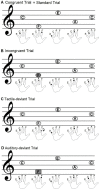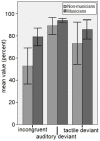Audio-tactile integration and the influence of musical training
- PMID: 24465675
- PMCID: PMC3897506
- DOI: 10.1371/journal.pone.0085743
Audio-tactile integration and the influence of musical training
Abstract
Perception of our environment is a multisensory experience; information from different sensory systems like the auditory, visual and tactile is constantly integrated. Complex tasks that require high temporal and spatial precision of multisensory integration put strong demands on the underlying networks but it is largely unknown how task experience shapes multisensory processing. Long-term musical training is an excellent model for brain plasticity because it shapes the human brain at functional and structural levels, affecting a network of brain areas. In the present study we used magnetoencephalography (MEG) to investigate how audio-tactile perception is integrated in the human brain and if musicians show enhancement of the corresponding activation compared to non-musicians. Using a paradigm that allowed the investigation of combined and separate auditory and tactile processing, we found a multisensory incongruency response, generated in frontal, cingulate and cerebellar regions, an auditory mismatch response generated mainly in the auditory cortex and a tactile mismatch response generated in frontal and cerebellar regions. The influence of musical training was seen in the audio-tactile as well as in the auditory condition, indicating enhanced higher-order processing in musicians, while the sources of the tactile MMN were not influenced by long-term musical training. Consistent with the predictive coding model, more basic, bottom-up sensory processing was relatively stable and less affected by expertise, whereas areas for top-down models of multisensory expectancies were modulated by training.
Conflict of interest statement
Figures







Similar articles
-
Musicians react faster and are better multisensory integrators.Brain Cogn. 2017 Feb;111:156-162. doi: 10.1016/j.bandc.2016.12.001. Epub 2016 Dec 12. Brain Cogn. 2017. PMID: 27978450
-
Musical expertise induces audiovisual integration of abstract congruency rules.J Neurosci. 2012 Dec 12;32(50):18196-203. doi: 10.1523/JNEUROSCI.1947-12.2012. J Neurosci. 2012. PMID: 23238733 Free PMC article.
-
Improved tactile frequency discrimination in musicians.Exp Brain Res. 2019 Jun;237(6):1575-1580. doi: 10.1007/s00221-019-05532-z. Epub 2019 Mar 29. Exp Brain Res. 2019. PMID: 30927044
-
The neural processing of complex sounds.Ann N Y Acad Sci. 2001 Jun;930:133-42. doi: 10.1111/j.1749-6632.2001.tb05729.x. Ann N Y Acad Sci. 2001. PMID: 11458824 Review.
-
Brain organization for music processing.Annu Rev Psychol. 2005;56:89-114. doi: 10.1146/annurev.psych.56.091103.070225. Annu Rev Psychol. 2005. PMID: 15709930 Review.
Cited by
-
Integration of somatosensory and motor-related information in the auditory system.Front Neurosci. 2022 Oct 18;16:1010211. doi: 10.3389/fnins.2022.1010211. eCollection 2022. Front Neurosci. 2022. PMID: 36330342 Free PMC article. Review.
-
The Case for Musical Instrument Training in Cerebral Palsy for Neurorehabilitation.Neural Plast. 2016;2016:1072301. doi: 10.1155/2016/1072301. Epub 2016 Oct 27. Neural Plast. 2016. PMID: 27867664 Free PMC article. Review.
-
The importance of sensory integration processes for action cascading.Sci Rep. 2015 Mar 30;5:9485. doi: 10.1038/srep09485. Sci Rep. 2015. PMID: 25820681 Free PMC article.
-
Imagine, Sing, Play- Combined Mental, Vocal and Physical Practice Improves Musical Performance.Front Psychol. 2021 Oct 25;12:757052. doi: 10.3389/fpsyg.2021.757052. eCollection 2021. Front Psychol. 2021. PMID: 34759873 Free PMC article.
-
Musical expertise is related to altered functional connectivity during audiovisual integration.Proc Natl Acad Sci U S A. 2015 Oct 6;112(40):12522-7. doi: 10.1073/pnas.1510662112. Epub 2015 Sep 14. Proc Natl Acad Sci U S A. 2015. PMID: 26371305 Free PMC article.
References
-
- McGurk H, MacDonald J (1976) Hearing lips and seeing voices. Nature 264: 746–748 Available: http://www.nature.com/nature/journal/v264/n5588/abs/264746a0.html. Accessed 2013 Feb 15. - PubMed
-
- Jäncke L (2009) Music drives brain plasticity. F1000 Biol Rep 1: 1–6 Available: http://www.pubmedcentral.nih.gov/articlerender.fcgi?artid=2948283&tool=p.... Accessed 2010 Nov 5. - PMC - PubMed
-
- Münte TF, Altenmüller E, Jäncke L (2002) The musician's brain as a model of neuroplasticity. Nat Rev Neurosci 3: 473–478 Available: http://www.ncbi.nlm.nih.gov/pubmed/12042882. Accessed 2013 Dec 10. - PubMed
-
- Jäncke L (2009) The plastic human brain. Restor Neurol Neurosci 27: 521–538 Available: http://www.ncbi.nlm.nih.gov/pubmed/19847074. Accessed 2010 Nov 3. - PubMed
-
- Pakarinen S, Lovio R, Huotilainen M, Alku P, Näätänen R, et al. (2009) Fast multi-feature paradigm for recording several mismatch negativities (MMNs) to phonetic and acoustic changes in speech sounds. Biol Psychol 82: 219–226 Available: http://www.ncbi.nlm.nih.gov/pubmed/19646504. Accessed 2013 Jan 30. - PubMed
MeSH terms
LinkOut - more resources
Full Text Sources
Other Literature Sources

